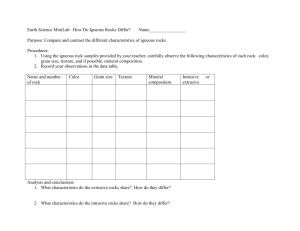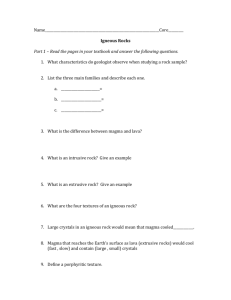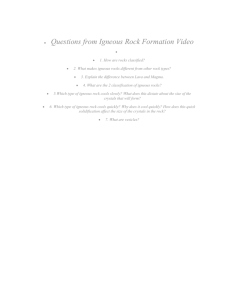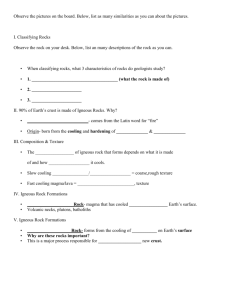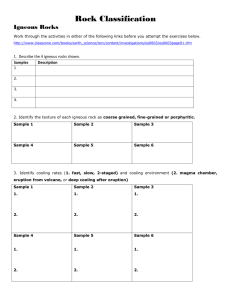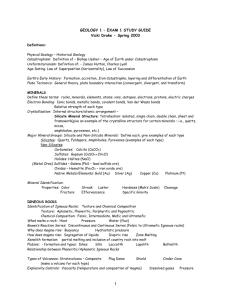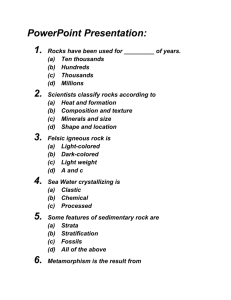Igneous Rock Study Guide
advertisement
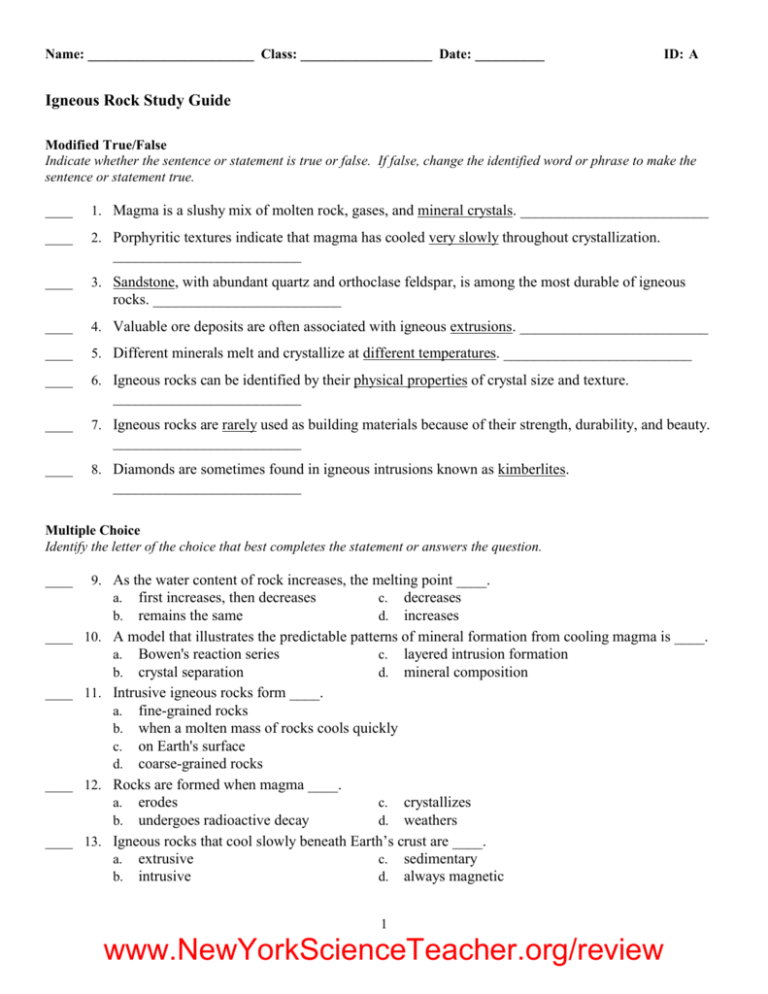
Name: ________________________ Class: ___________________ Date: __________ ID: A Igneous Rock Study Guide Modified True/False Indicate whether the sentence or statement is true or false. If false, change the identified word or phrase to make the sentence or statement true. ____ 1. Magma is a slushy mix of molten rock, gases, and mineral crystals. _________________________ ____ 2. Porphyritic textures indicate that magma has cooled very slowly throughout crystallization. _________________________ ____ 3. Sandstone, with abundant quartz and orthoclase feldspar, is among the most durable of igneous rocks. _________________________ ____ 4. Valuable ore deposits are often associated with igneous extrusions. _________________________ ____ 5. Different minerals melt and crystallize at different temperatures. _________________________ ____ 6. Igneous rocks can be identified by their physical properties of crystal size and texture. _________________________ ____ 7. Igneous rocks are rarely used as building materials because of their strength, durability, and beauty. _________________________ ____ 8. Diamonds are sometimes found in igneous intrusions known as kimberlites. _________________________ Multiple Choice Identify the letter of the choice that best completes the statement or answers the question. ____ 9. As the water content of rock increases, the melting point ____. a. first increases, then decreases c. decreases b. remains the same d. increases ____ 10. A model that illustrates the predictable patterns of mineral formation from cooling magma is ____. a. Bowen's reaction series c. layered intrusion formation b. crystal separation d. mineral composition ____ 11. Intrusive igneous rocks form ____. a. fine-grained rocks b. when a molten mass of rocks cools quickly c. on Earth's surface d. coarse-grained rocks ____ 12. Rocks are formed when magma ____. a. erodes b. undergoes radioactive decay crystallizes weathers ____ 13. Igneous rocks that cool slowly beneath Earth’s crust are ____. a. extrusive c. sedimentary b. intrusive d. always magnetic c. d. 1 www.NewYorkScienceTeacher.org/review Name: ________________________ ID: A ____ 14. Igneous rocks that cool quickly on Earth’s surface are ____. a. extrusive c. metamorphic b. intrusive d. always magnetic ____ 15. Extrusive rocks, which cool more rapidly than intrusive rocks, are generally more ____. a. coarsely grained c. radioactive b. finely grained d. magnetic ____ 16. Factors that affect a rock’s melting point include ____. a. pressure and water content c. rarity b. value as a gem d. usefulness as a building material ____ 17. Valuable ore deposits and gem crystals are often associated with ____. a. oceans c. thin crustal areas b. oil deposits d. igneous intrusions Completion Complete each sentence or statement. 18. Rock formed from the crystallization of magma is called _________________________. 19. ___________________________________ illustrates the relationship between cooling magma and mineral formation. 20. A(n) ____________________ rock, such as dunite, has low silica content and very high iron and magnesium content. 21. A rock that has grains of two different sizes has ____________________ texture. 22. A(n) ____________________ is a vein of extremely large-grained minerals. 23. A rare, ultramafic rock that might contain diamonds is a(n) ____________________. Matching Match each item with the correct statement below. a. felsic e. pegmatite b. kimberlite f. porphyritic c. lava g. ultramafic d. mafic Magma that flows out onto Earth's surface Light-colored rock such as granite that has high silica content Dark-colored rock such as gabbro that is rich in iron and magnesium Rock that is very high in iron and magnesium Texture characterized by large, well-formed crystals surrounded by finer-grained crystals of the same mineral ____ 29. Vein of extremely large-grained minerals ____ 30. Ultramafic rock that can contains diamonds ____ ____ ____ ____ ____ 24. 25. 26. 27. 28. 2 www.NewYorkScienceTeacher.org/review Name: ________________________ ID: A Match each item with the correct statement below. a. Extrusive rock g. Porphyritic texture b. Intrusive rock h. Layered intrusion c. Felsic rock i. Pegmatite d. Intermediate rock j. Kimberlite e. Mafic rock k. Zoned crystal f. Ultramafic rock ____ ____ ____ ____ ____ ____ ____ ____ ____ ____ ____ 31. 32. 33. 34. 35. 36. 37. 38. 39. 40. 41. Dark color with low silica content; high iron/magnesium content Vein of extremely large-grained minerals Sodium-rich outer layers, calcium-rich core Coarse-grained Composed of distinct bands of minerals Fine-grained, glassy Long pipelike intrusion; may contain diamonds Light color with high silica content Large and small crystals in same rock Very dark color with very high levels of iron/magnesium Medium color with moderate silica content Short Answer 42. How does the geothermal gradient of continental crust differ from that of oceanic crust? 43. What causes the difference in grain size between intrusive igneous rocks and extrusive Igneous rocks? 3 www.NewYorkScienceTeacher.org/review Name: ________________________ ID: A 44. How is partial melting related to fractional crystallization? 45. A group of igneous rocks are found. The rocks all have very low silica contents. Based on this characteristic alone, to what group of igneous rocks do these rocks likely belong? Compare and contrast each pair of related terms or phrases. 46. intrusive igneous rock, extrusive igneous rock 47. magma, lava 48. felsic, mafic 49. Which rock type or feature forms when rapid cooling of magma does not allow its calcium-rich core to react completely with the magma? 50. Which rock type or feature forms when crystallization begins slowly and then becomes rapid? 51. Which rock type or feature may be formed when magma is forced rapidly upward, creating pipelike intrusions? 52. In general, do intrusive rocks crystallize more rapidly or less rapidly than do extrusive rocks? 53. What is partial melting? Explain how partial melting affects igneous rock formation. 54. What is fractional crystallization? Does it add or remove elements from magma? Explain your answer. 55. What relationship does Bowen’s reaction series illustrate? What crystallization patterns did Bowen discover in feldspars and iron-rich minerals? 56. What are the three main groups of igneous rocks? What are the characteristics of each group? 57. Why would crystals formed early in magma crystallization have larger, better-shaped crystals than those that formed later? 58. What is porphyritic texture? What sequence of events produces porphyritic texture in rocks? 4 www.NewYorkScienceTeacher.org/review Name: ________________________ ID: A The diagram shows the proportions of minerals in common igneous rocks. Use the diagram to answer the following questions. 59. What four groups of igneous rocks are shown in the diagram? 60. Which rocks are lighter in color—those on the left side of the diagram or those on the right? 61. What categories of rock grain are shown on the diagram? 62. How are silica content and color related in this diagram? 63. Do the groups of igneous rocks shown in the diagram exhibit an abrupt change from one group to another or a continuous change from one rock type to the next? Explain your answer. 64. Rock Sample A is coarse-grained, 90 percent olivine, and 10 percent pyroxene. What is the name of the rock? What group is it in? 65. Is rock Sample A dark or light in color? 66. Rock Sample B is coarse-grained, 25 percent quartz, 65 percent feldspar, and 10 percent unidentified minerals. What is the name of the rock? What group is it in? 67. If a rock sample with the same mineral content as Sample B was fine-grained instead of coarse-grained, what would its name be? 68. Do calcium-rich feldspars occur in felsic rocks or in mafic rocks? 69. What is the primary mineral component of felsic rocks? Ultramafic rocks? 5 www.NewYorkScienceTeacher.org/review Name: ________________________ ID: A Problem 70. According to the diagram below, what elements are removed from this particular magma during fractional crystallization? What effect does this have on the overall proportions of the remaining elements—Al, Ca, Si, O, Na, and K—in the magma? 6 www.NewYorkScienceTeacher.org/review ID: A Igneous Rock Study Guide Answer Section MODIFIED TRUE/FALSE 1. 2. 3. 4. 5. 6. 7. 8. T F, slowly, then quickly F, Granite F, intrusions T T F, often T MULTIPLE CHOICE 9. 10. 11. 12. 13. 14. 15. 16. 17. C A D C B A B A D COMPLETION 18. 19. 20. 21. 22. 23. igneous rock Bowen’s reaction series ultramific porphyritic pegmatite kimberlite MATCHING 24. 25. 26. 27. 28. 29. C A D G F E 1 www.NewYorkScienceTeacher.org/review ID: A 30. B 31. 32. 33. 34. 35. 36. 37. 38. 39. 40. 41. F D H K A J I E B G C SHORT ANSWER 42. At depths up to about 300 km, the geothermal gradient is hotter in the oceanic crust than in the 43. 44. 45. 46. 47. 48. 49. 50. 51. 52. 53. 54. continental crust. When rocks cool slowly, as do intrusive igneous rocks, they have time to form large crystals, unlike rocks that cool quickly, which tend to form small crystals. Partial melting and fractional crystallization are similar processes in that the composition of magma may change with either. During fractional crystallization, however, the changes occur because as each group of minerals crystallizes, it removes elements from the remaining magma instead of adding new elements as occurs in partial melting. The rocks are either mafic or ultramafic igneous rocks, depending on how high the levels of iron and magnesium are. Both describe the formation of igneous rock. Fine-grained rocks that cool quickly on Earth’s surface are extrusive igneous rocks. Coarse-grained igneous rocks that cool slowly beneath Earth’s surface are intrusive igneous rocks. Both are molten rock. Magma is molten rock below Earth’s surface, while lava is magma that flows out onto Earth’s surface. Both are groups of igneous rocks. Felsic rocks are light-colored, have high silica content, and contain quartz and feldspars. Mafic rocks are darker-colored, have low silica content, and high iron and magnesium content. a zoned crystal porphyritic texture kimberlite less rapidly Partial melting describes how different minerals melt at different temperatures. The resulting magma and the rocks that form when the magma cools have a different chemical composition than that of the original rock. Fractional crystallization describes how different minerals form at different temperatures. It removes elements because as the minerals crystallize, they are no longer part of the magma. 2 www.NewYorkScienceTeacher.org/review ID: A 55. The relationship shown is between cooling magma and mineral formation. Minerals crystallize from 56. 57. 58. 59. 60. 61. 62. 63. 64. 65. 66. 67. 68. 69. magma in a sequential pattern, with feldspar minerals undergoing a continuous, gradual change of mineral composition, and iron-rich minerals undergoing an abrupt change. Igneous rocks are classified as felsic, mafic, and intermediate. Felsic rocks are light-colored, have high silica content, and contain quartz and feldspars. Mafic rocks are dark-colored, have low silica content, and are rich in iron and magnesium. Intermediate rocks lie between felsic and mafic rocks in silica and iron content. Early-forming, slower-cooling minerals may have time to form larger, well-shaped crystals because crystallization occurs in an unconfined space, while later-forming, quick-cooling crystals have irregular shapes because they form in a confined space and lack time to form. A rock with porphyritic texture contains both large and small crystals. A porphyritic texture indicates a complex cooling history in which a slowly cooling magma begins to cool rapidly, forming smaller crystals. felsic, intermediate, mafic, ultramafic The rocks on the left side are lighter in color. coarse-grained, fine-grained, and very coarse-grained Rocks with high silica content are light, while rocks with low silica content are dark. There is a continuous change as proportions of the minerals that make up the rock groups change gradually from one to the next. It is peridotite. It is categorized as ultramafic. It is dark. It is granite. It is categorized as felsic. rhyolite in mafic rocks feldspar; olivine PROBLEM 70. Mg and Fe are removed and crystallized. This increases the overall proportion of all other elements in the magma. 3 www.NewYorkScienceTeacher.org/review
